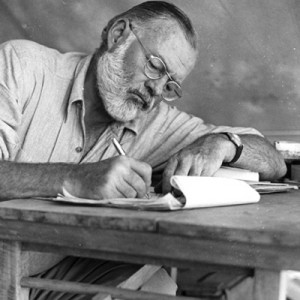 I read my own books sometimes to cheer me when it is hard to write, and then I remember that it was always difficult, and how nearly impossible it was sometimes.
I read my own books sometimes to cheer me when it is hard to write, and then I remember that it was always difficult, and how nearly impossible it was sometimes.
— Ernest Hemingway
People love to tell artists that they’re jealous of them. Wow, you write, that’s great. I wish I had something like that in my life. Generally, I grab them, slap them a few times, dunk them in a nearby lake, hook them up to a motorcycle battery, and then torture them until they take it back.
It’s like when people say, “You’re so lucky you got recovery early.” Uh huh, so lucky I was suicidal at nineteen, a monk at 20 (celibacy vows intact), and I celebrated my 21st birthday watching a bad movie with people who didn’t really give a crap that it was my 21st birthday. Yeah, so lucky.

I think the reason why people are fascinated by artists is that everyone is an artist, deep down, but doubt, fear, general angst, drive them away from it. So it’s like when you say you’re an artist, it’s like saying you’ve just come from visiting a distant planet. Everybody likes an astronaut because they’re tough, skilled, blessed. Artists, writers, same thing.
These series of blog posts are for those who want to be astronauts of the spirit, who want to overcome whatever madness drove them away from creating. The 12 steps have helped millions of people overcome life-crushing, heart-wounding addictions, and they can help those who want to create art but find themselves caged by their own deluded, self-centered fear. The genius behind the 12 steps is that they give us a choice on what we want to do, rather than having us running away whenever some compulsion hits.
And it’s 12 steps. Just 12. Simple. But not necessarily easy. And for those not suffering from a crippling addiction, they can pretend they are. What are you doing tonight, Ed? Working the 12 steps. For your gummy bear addiction? No, I’m a writer. I have a writing addiction I want to nurture. How cool is that?
In 1955, Bill Wilson wrote a series of essays on the 12 steps and 12 traditions of Alcoholics Anonymous that was published in a book, in AA circles called the 12 by 12, and of course, there are a bunch of fascists who are always there to correct people. It’s 12 and 12, not 12×12, ya drunk yodeling idiot. This series of blog posts is going to have a similar format. Next week we’ll have a brief biography, which of course, won’t be hard for me. It’s the old, “I’m not much, but I’m all I think about.” I know, last week I promised a biography, but well, um, the internet breeds disappointment. I’m just doing my job.
Again, I want to be clear, I’m going to keep whatever fellowship I belong to anonymous because the point of this is not to promote any one 12-step program, but to show how people can use the 12 steps to improve their creative lives. And my story is just an example, a kind of, “If this yutz can do it, you can too.” And the 12 steps of Alcoholics Anonymous are in the public domain, though I plan to change them, just a bit, because we’re not dealing with alcoholism, or narcotic addiction, or gambling, or sex, or overeating. Ha, reads like a list of ‘these are a few of my favorite things.’ We’re dealing with the generic problem of artistic angst and how to overcome it.
I’ll be using stories from my own life as well as other writers I’ve met, because at the heart of things, 12-step programs are about storytelling. “We heal through our mouths,” or so the saying goes.
And this isn’t going to be a blog series of advice, tips, blah, blah, blah. It’s going to be instructive. Do this. Do this. Do this. In 12-step talk, we take the actions and our thinking changes. You can’t fix a broken mind with a broken mind. It takes action. Bring the body and the mind will follow.
I’m goin’ biblical, Faith without works is dead. Bill W. loved that little piece of quotation magic.
 Next week, I promise, the biography of me, or “Why I should be the one to blog about this stuff!”
Next week, I promise, the biography of me, or “Why I should be the one to blog about this stuff!”
